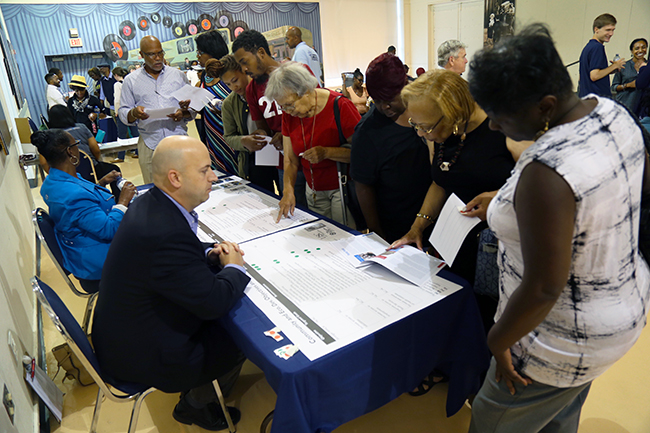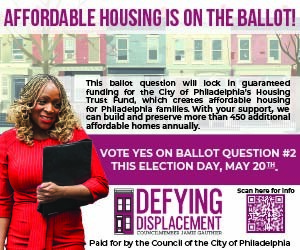
Residents rank priorities as part of drafting the Walnut Hill neighborhood plan last night at The Enterprise Center (Photo by Mike Lyons/West Philly Local).
A group of Walnut Hill residents met last night to put the finishing touches on a five-year plan that they hope will eliminate blight, improve local business and affordable housing opportunities and cut down on litter in the neighborhood.
The meeting was the final in a series of gatherings to create a plan that balances the demographic changes in the neighborhood in recent years with the needs and interests of long-time residents.
Walnut Hill’s borders are Market Street to the north, Spruce Street to the south, 52nd Street to the west and 45th Street to the east. The neighborhood’s population has changed a lot since the 2000 census. The number of white residents has risen from 12 to 23 percent and the number of African American residents has declined from 81 percent in 2000 to 67 percent in 2010, the year of the latest census. That number has probably dropped even further since then.
In the same time frame the media income has increased $10,000 per year with adjustments for inflation. About 60 percent of the population are renters. Here is the last plan, released in 2007.
The plan authors from The Enterprise Center asked residents last night to rank priorities in building development, streets and community and economic development.
Those priorities included increasing retail and employment diversity in the neighborhood through things like storefront improvement grants from the University City District (the 48th Street Grille got one of these) and creating opportunities for affordable housing. Residents also saw reducing litter and improving the shopping atmosphere along commercial corridors like 52nd Street.
Other priorities included access to healthy food and pedestrian safety (particularly along Chestnut Street).
Officials from The Enterprise Center, which is responsible for writing the plan with cooperation from the Walnut Hill Community Association and the University City District, say about 90 percent of the plan is done. They will likely release it in the fall.
– Mike Lyons








August 28th, 2015 at 7:44 pm
How’s this for “reducing litter”? Keep your own block clean, both business and residential. Many of the streets that are normally litter free have homeowners who pick up trash (usually someone else’s thrown from car windows or dropped after eating fast food). The further west you go the more trash in the streets and on sidewalks. Are these homeowners or renters sitting on their porches and stoops that can’t be bothered to clean up trash?
August 30th, 2015 at 10:02 am
Or people could stop throwing trash on the ground
September 2nd, 2015 at 8:51 am
I would think that if this handful of Walnut Hill residents bothered to come to a community meeting, they’re probably also the few who bother to clean up their own blocks. So no need to point the finger at them, specifically. But there’s only so much a handful of community-minded residents can do.
September 2nd, 2015 at 3:29 pm
Who’s pointing a finger at people attending the meeting? However, how many residents does it take to clean a block? Not many walking the block a couple times a week with a trash bag. If it were my block it would take one resident. Me! If I lived on a trashy block I’d do something about it as a homeowner. Why is there such a notable difference when walking west on Larchwood crossing 49th St. and trash on sidewalks and gutters? While we’re at it you would think with all the trashcans in Malcolm X Park that there wouldn’t be so much trash. It would be a great park without the filth.
November 20th, 2015 at 12:05 pm
I was shocked when I realized how much litter on the streets is caused by one culprit in particular- the squirrels in Malcolm X park. I counted over 50 of them while walking diagonally through the park a couple weeks ago, and those little fur monsters go through the uncovered trash cans like they are high on speed, tossing trash left and right as they forage through them. When they are done at a particular trash can, it looks like a bomb went off and then the wind starts scattering the debris in all directions. Yes, people are to blame for much of the litter, but so are those destructive bushy-tailed rats.
November 20th, 2015 at 7:33 pm
At least they know when to stop and move on. Probably when there’s nothing left but GMO stuff.
November 21st, 2015 at 3:25 pm
Don’t assume residents aren’t cleaning up litter. On my block it is a full-time job. As soon as you sweep up the sidewalk and gutter, it gets trashed again, sometimes within the hour. It’s people walking by, kids and adults who don’t know or remember what a trash can is for and frankly don’t care. I try, but it’s not easy to keep up with.
November 23rd, 2015 at 11:16 am
thanks barb for a voice of reason. I live on walnut near 51st, a heavily traveled and littered-in area. I see neighbors out cleaning up regularly, but it’s no match for the trash from pedestrian and vehicle traffic, construction sites, etc. there are also no actual public trash cans, and, might I remind those living further east, no red-shirted university city district sweepers paid to sanitize blocks for students and yuppies. residents with lower incomes have less time and resources to devote to neighborhood cleanup and involvement. consider the institutions at play before you criticize.
November 24th, 2015 at 11:38 am
c, guess what- there is plenty of litter on the streets near the campus too. My wife and I work fulltime, we have a 1.5 year old daughter, we have pets, we have obligations in life, and we find it hard to find time to clean up the sidewalk and streets around our home near Malcolm X Park, BUT we still manage to do it. I didn’t realize that the level of your income affects how much time you have to devote to sweeping up trash and raking leaves. There are littering buffoons and lazy homeowners throughout the city and at aall levels of income, so stop using the “institutions at play” as an excuse. You even said that you “see neighbors out cleaning up regularly,” so just imagine how bad it would be if those great folks stopped caring or could no longer find the time to make a difference in their community.